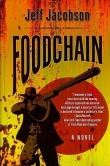
Текст книги "The Long Mars"
Автор книги: Terence David John Pratchett
Соавторы: Stephen Baxter
Жанры:
Научная фантастика
,сообщить о нарушении
Текущая страница: 12 (всего у книги 25 страниц)
20
AS IT HAPPENED, Sally slept only a couple of hours before she was woken, not by Frank, but by another sudden lurch of the glider. She sat up with a start, reaching for her faceplate.
The cabin seemed dark, and she wondered if they had fallen into another storm. Then she realized that it was merely that the sun was low, setting in the west, and the colour was draining from the sky – but that colour, in this particular world, was a kind of bruised-purple, not the usual dusty brown.
Frank and Willis were talking quietly over the comms. Frank said, ‘Flying into this world with its thicker air was like slamming into a wall. Worse than the dust storm. We didn’t anticipate that.’
‘Yeah, but the gliders are coping.’
‘Possibly we could rig some kind of cut-out, so we don’t step further. Or maybe go up to higher altitude, where the air will never get catastrophically thick . . .’
As they talked Sally surveyed her surroundings. They were banking over a plain of dust and broken rock, not far north of the mouth of the enduring Mangala feature. In nearly twelve hours of travelling they had crossed more than forty thousand worlds, Sally saw, glancing over Frank’s shoulders at the instruments. And now this, something new and different. The air here was thicker, and oxygenated, and contained water vapour. It wasn’t as generous an atmosphere as Gap Mars, but more so than any other they’d passed through since, it seemed.
And on the ground below there was movement.
At first Sally, peering down, saw what looked like ripples in the dust, but ripples that slid and evolved as she watched. The low sun cast long shadows which made this diorama easy to follow.
Then a kind of body emerged from the dust.
She saw a gaping mouth, then a tubular carcass, coated with chitinous plates that glistened in the low sunlight. It was almost like watching a whale surface from the sea. Then that great mouth opened wide, scooping in the sand. Now Sally saw more such shapes emerge from the ground, none of them as large as the first: young, perhaps, immature versions. They glided through the dust, propelled by flippers; Sally counted a dozen pairs of limbs on the big leader.
‘Life on Mars,’ she breathed. ‘Animal life.’
‘Yeah,’ Willis called. ‘Like whales in a sea of dust, filter-feeding. And there’s no Gap here. This may have some common root with the life of the local Earth. But it’s a very remote relation indeed.’
‘It’s hard to get a sense of scale.’
Frank said, ‘That big mother is the size of a nuclear submarine. And maybe it, she, is a mother . . . What a vision!’
Willis grunted. ‘It’s logic. An ecology shaped by its environment. Here, the dust must be fine enough to act as a fluid, to support something like a marine biota—’
‘Oh, keep the lectures. Look down there! It’s like a homage to old science fiction dreams. There was a book I grew up with, published twenty years before I was even born – I learned more about ecology from that novel than I ever did in class – and if you could ever argue that science fiction has no predictive value—’
Sally said gently, ‘Turn it down, fan boy.’
‘Sorry.’
Willis said now, ‘Shall we go back to something resembling rationality? Why are we seeing these – whales – in this particular world? Because it’s warmer and wetter here – not by much, but some. The local air contains a lot of volcanic products. Sulphur dioxide—’
Frank asked, ‘Volcano summer?’
‘I guess so.’
‘Just as you predicted, then, Willis.’
‘We need to confirm it. I’d like to deploy a probe here. A slow drone will do; we have some designed to be carried by balloons. If it was a supervolcano, a Yellowstone, the most likely location is Arabia, a very ancient terrain on the far side of the planet. Maybe that’s where we’ll find the caldera.’
Sally frowned. ‘I’m not following you. What have volcanoes got to do with anything?’
Her father said, ‘I think this world is a Joker. Look, Sally, life – extant, complex, active life anyhow – is going to be rare in the Long Mars. In the Long Earth, the worlds are mostly living, but the Jokers, the exceptions that have suffered from some calamity, are often free of life. Right? Here it’s the other way around. The Long Mars is mostly dead. It’s only the Jokers, rare islands of warmth, that can host life . . . When it was young, Mars was warm and wet, with a thick blanket of air, and deep oceans. Like Earth, in many ways. And life got started.’
‘But Mars froze out. Alexei told me about this.’
‘But life persists, Sally, life huddles underground, clinging on as spores, or as bacteria munching hydrogen or sulphides or dissolved organics in long-buried salty aquifers – even as encysted hibernators. Resistant to heat and cold, to radiation, to aridity, to a lack of oxygen, to extreme ultraviolet . . .
‘And sometimes life has the chance to do more. Imagine for instance an icy asteroid captured in Martian orbit, gradually breaking up, raining its mass on to the planet, seeding it with water and other volatiles . . .’
He sketched other ways for a Mars to come alive, if briefly. A massive asteroid or comet impact could leave behind a crater so hot that it might stay warm enough for centuries, even millennia, warm enough to host a liquid-water crater lake. Or there might be ‘axial excursions’, as Willis put it, times when the planet’s rotation axis tipped or bobbed, bringing sunlight to the polar regions, and shaking up the world with earthquakes and volcanism. Again, there was more of that on Mars than on the Earth, because Mars had no massive, spin-stabilizing moon. Indeed, it seemed from their observations so far that most Marses had no moons at all; the twin moons of the Mars of Datum Earth, Phobos and Deimos, evidently captured asteroids, were unusual – the Datum Earth Mars, it turned out, was itself a Joker.
‘And on this world,’ he said, ‘this Joker, we’re coming to the end of a volcano summer. Mars is still warm inside. Every so often the big Tharsis volcanoes blow their tops. On Earth, volcanoes are disasters. Here they belch out a whole replacement atmosphere, of carbon dioxide and methane and other products, and a blanket of dust and ash that warms the world up enough for the water to come gushing back out of the permafrost.
‘On this Mars a recent eruption has warmed the air, for a hundred or a thousand or ten thousand years. Seeds, dormant perhaps for megayears, sprout hungrily, and the Martian equivalent of blue-green algae get to work enriching the volcanic soup with oxygen. Those little bugs have evolved to survive, and to be efficient when they get their chance. It must be an incredible sight, Mars turning green in just a few thousand years, like a natural terraforming. And life forms like the whales down there have their moment in the sun. But then, sooner or later, quickly or slowly, the heat leaks away, and the air starts to thin. The end, when it comes, is probably rapid.’
Sally nodded. ‘And then it’s back to the dustbowl.’
‘Yes. The Datum scientists believed they had mapped five such episodes, five summers lost in deep time, on our copy of Mars. The first was about a billion years after the planet formed, the last one a hundred million years back . . .’
‘And similarly,’ she said, ‘if we travel across the Long Mars, we’re going to find rare islands of life – as rare in stepwise space as those episodes on a single Mars are rare in time.’
‘Something like that. That’s my theory, anyhow. And it seems to be borne out so far.’
‘Look at that,’ murmured Frank, looking down. ‘One of those babies got separated from the pack.’
Sally looked down to see. The infant whale, if it was an infant, had indeed become detached from the pack that surrounded the big mother.
And a new type of creature emerged, as if out of nowhere, to attack the lost little one. Sally glimpsed huge forms, with flexible armour plates but much more compact than the whales, like big hungry crustaceans with eyeballs on stalks. They all scooted across the surface of the dust, or just under it.
When they caught the infant whale, they fell on it. The whale thrashed and struggled, throwing up great sprays of dirt.
Willis called, ‘Are we recording this, Frank?’
‘You got it,’ Frank said. ‘Each of those crustacean predators is the size of a truck. And notice how they move: low down on the surface, or even under it. I bet that’s a low-gravity adaptation; they’re clinging to the ground for traction, for speed. You want we should go down, take some samples? My vote is no, by the way; it looks kind of hazardous down there and our gliders are somewhat fragile.’
‘We go on,’ Willis said. ‘After all, it’s not life I’m after but sapience, and I don’t see much sign of that down below. Another hour? Then we’ll pick some safely dead world to camp for the night. On my zero: three, two—’
Sally caught one last glimpse of the scene on the torn-up ground below. What looked like blood seeped from a dozen wounds in the baby whale’s hide, as the crustaceans ripped and tore: blood that was purple in the low light.
And then the scene was whisked away, to be replaced by lifelessness, a plain of scattered rocks that might not have moved for a million years, casting long meaningless shadows as the sun set on another eventless day, on another dormant Mars.
21
PROFESSOR WOTAN ULM, now of the University of Oxford East 5, author of the bestselling if controversial book An Untuned Golden String: The Higher-Dimensional Topology of the Long Earth, appeared on a news channel run by the Britain West 7 Broadcasting Corporation, responding to questions on the nature of ‘soft places’, as those mysterious short cuts, widely rumoured to be more than mere stepper legends, were increasingly becoming known.
‘I do see that going through a soft place would be like wearing seven-league boots, Wotan – may I call you Wotan?’
‘No, you may not.’
‘But it would help if I understood how you can make these seven-league-boot jumps.’
‘Actually a better metaphor for a soft place is a wormhole. A fixed passageway between two points. As in the movie Contact. You remember that?’
‘Is that the porno where—’
‘No. Stargate, then. What about that? Oh, for some modern cultural references. Never mind! There is in fact some relevant theory. Young man, have you ever heard of a Mellanier Sequence diagram?’
‘No.’
‘It’ll never be properly drawn until they invent n-dimensional printing, but basically it portrays the Long Earth as a tangled ball of string. Or, if you can stomach it, as a vast intestine. Datum Earth is a dot somewhere in the region of the appendix. Mathematically this tangle may – and I emphasize the “may” – be represented by a solenoid, a particular mathematical structure like a self-crossing string, a mixture of linear order and chaos . . . You look as blank as a chimp faced with a banana fitted with a zip. Well, never mind.
‘The point is that simple Stepper technology allows us to move “up” or “down” the gut, you see, along the string of worlds. But Mellanier, even before the existence of the soft places started to become widely known, argued on theoretical grounds that it might be possible to break through into an adjoining strand. Rather than walk all the way around the string, you see. An effective short cut.’
‘Mellanier. I do remember him. Face all over the media a few years after Step Day. Princeton, isn’t he?’
‘That’s him. He got a lot right, but only dipped his toe in the theoretical waters.’
‘You don’t seem to like him very much, Wotan. Why should some rival academic from Princeton get your goat?’
‘Because Claude Mellanier is a fraud who fed off the analyses of Willis Linsay, and mine, repackaged them, dumbed them down, and passed them off as his own.’
‘The man won a Nobel Prize, didn’t he, Wotan?’
‘That’s because the Nobel committee are idiots nearly as blithering as you.’
‘Also he published a bestselling book—’
‘And don’t call me Wotan. Oh, must you plant me before these pithecine buffoons, Jocasta?’
22
BY THE END OF February, the Armstrong and Cernan had passed Earth West 30,000,000. There was no particular celebration – and nor had there been a few days back, when the ships had passed 20,000,000, and so beaten the five-year-old Chinese record. Not in the public spaces anyhow, at Maggie’s quiet order.
With the sheaf of worlds dominated by crabs and other crustaceans far behind, now they passed through a band of worlds where – as the biologists discovered on scooping up samples of pond scum – not only was there no multicellular life, no animals, no vegetation, there was often no evidence of complex cellular life: that is, no cells with internal nuclei, like those of Maggie Kauffman’s own body. Only the most simple of bacteria dwelled here, in mats and banks.
The crew called these ‘purple scum worlds’.
Still, in such worlds there could be complexity, of a different sort. They found structures like stromatolites, mounds of bacteria built up layer by layer in the sunlight, mindlessly cooperating in what might on Datum Earth have been called primitive ecosystems. But after billions of years of a different evolution, there was nothing primitive about these structures. Especially not the ones that crept up on an unwary crewman, taking samples with her back turned . . .
Two days’ flight later, at around Earth West 35,000,000, after millions of scum worlds all more or less identical, they encountered another band of worlds with their own peculiarity. Here oxygen levels in the air were very low, carbon dioxide high. The airships stopped at random on one such world – Earth West 35,693,562. Biologists in oxygen masks cautiously explored the shore of an arid continent. Even by the standards of the ‘purple scum’ worlds, this was an Earth poor in life.
It took some detective work on a larger scale to figure out the cause. Under Gerry Hemingway’s prompting, Maggie authorized the launch of balloons, sounding-rockets, and one of their small stock of precious nanosat launchers, and a global map was assembled. Here, North America had united with most of the world’s other continents, rafts of granite floating on mantle currents, to form a single supercontinent – like the Datum’s Pangaea, Maggie was told, which had broken up a quarter of a billion years back. One huge continent, and nothing else but ocean.
And supercontinent worlds, it turned out – just as the Chinese had found, Maggie discovered, consulting with Wu Yue-Sai – weren’t particular hospitable to life. The continent’s vast interior was worn down and arid; it was like one gigantic Australia, with only the coastal regions showing any kind of fecundity. The expedition pushed on, across one supercontinent world after another – the ‘Pangaean Belt’, the geographers called it. They saw no sign of life more complex than stromatolites at the coastal fringes, and if some kind of exotic critter roamed the tremendous plains of some footprints of these world continents, well, Maggie was content to leave the discovery to future travellers.
The Pangaean Belt turned out to be about fifteen million worlds thick. Fifteen million: sometimes Maggie struggled to grasp the significance of such numbers. The width of the Pangaeas alone was ten times the stepwise distance between the Datum and Valhalla, for instance, a reasonable measure of the width of the Long Earth as colonized by human beings in the generation since Step Day. Yet, travelling at the airships’ nominal cruise speed, they crossed it in a week.
After the Pangaeas, fifty million worlds from home, they entered yet another purple scum belt, where at least the scattered continents provided varied scenery. The atmospheric and climate conditions were often close enough to the Datum that Maggie could authorize shore leave without significant protective clothing, and her crews of very healthy, mostly very young people could escape from the roomy but confined interiors of the gondolas. But there was nothing to do down there, nothing to see – pond scum didn’t count – and people kind of clowned around aimlessly. There was only so much fun you could get out of lobbing rocks at stromatolites.
Snowy, the beagle, was different, however. Maggie watched him stride alone across the most featureless of landscapes, his extra ordinary animal-human body held erect in the Navy uniform Maggie had had specially tailored for him, his wolf eyes glittering, his head tipped back so his nostrils could drink in the local scents. He seemed to find something of interest in every world they called at. And he kept his own log, a vocal record rigged up for him by Harry Ryan since his people mostly lacked conventional literacy. Maggie promised herself to get that log transcribed and studied. She had the feeling it would describe a voyage perceived quite differently from the human crew’s experience. Which, of course, was why Snowy was here.
She tried to talk to Mac about Snowy, and whatever problem the two of them had. All she got was stony silence, a Mac speciality when he was in the mood.
When Snowy was off the ship Shi-mi would come out of Maggie’s rooms and run around the gondola of the Armstrong, presumably letting off steam in her own way, and submitting to being spoiled a little by the crew. Save for Mac, of course.
They pushed on, thousands upon thousands of steps. Even Jokers seemed sparse out here. Maggie fretted that the journey was turning into a kind of experiment into mass sensory deprivation. An unexpected hazard for a pioneer, she thought.
At first they kept the nominal cruise speed at a little over two million steps a day, achieved by stepping at fifty steps per second for around twelve hours’ run-time per day. Maggie was mindful that she was running two essentially experimental ships here, and Harry Ryan – backed up by his Chinese counterpart Bill Feng with whom, after initial suspicion, he had formed an unlikely buddy-buddy partnership – was resistant to any change to his preplanned test routines. But Maggie pushed Harry to up the running time to eighteen hours a day, enabling a transit rate closer to three million steps daily, rather than two. That still allowed for two hours’ downtime for the engine in the average watch, and she permitted Harry to have one full day per week without any stepping, for tests and overhauls on both boats.
Meanwhile she tried to keep the crews occupied. Luckily the gondolas were big enough to allow room for physical exercise and training, even in flight. She got together with Sergeant Mike McKibben, the commander of the two chalks of marines she had on board the airships, and fixed up joint exercises to keep both contingents happy. She also allowed, with caution, some competitive sports between the two services, Navy versus marines, from squash to Scrabble, McKibben’s surprising pet love.
She did quietly order Nathan to ensure that her crews’ salaries were firewalled so they couldn’t be gambled away on the turn of a high-scoring tile.
‘Yes, Captain. Should I warn Mike McKibben to do the same for his guys?’
She grinned. ‘Let’s see if he thinks of that for himself.’
‘Yes, Captain.’
Even at the increased rate, it took nineteen more days before they left behind the purple scum.
Joe Mackenzie, one night towards the end of that interval, revealed to Maggie that he too was keeping a kind of log of the trip.
‘My God, Mac, is everybody on these damn ships keeping a diary? We’re like a dysfunctional White House.’
‘It’s a solitary habit, but there are worse. And, according to my personal log – you know, it’s hard to grasp the scale of what we’re doing here, because epic stepwise journeys are new, whereas we’ve been making long geographical journeys on Earth since, what? The Vikings, the Polynesians? But even so it seems to me we’re coming up on a milestone, of sorts. Look – when Armstrong flew to the moon, he was undertaking a journey on a scale that dwarfed anything in human history, or indeed prehistory. The distance to the moon, two hundred and forty thousand miles out, is about sixty times the radius of the Earth. OK? Now, Datum to Valhalla is the civilized Long Earth, as much as it’s civilized at all. That’s around one point four million steps. And sixty times that distance, stepwise, is—’
She figured it quickly. ‘About eighty-four million.’
‘Which milestone we’re due to pass tomorrow.’ He raised the glass of single malt she’d poured for him. ‘Whatever comes next for us, in comparison with other human achievements we’ve achieved our personal moon shot, Maggie.’
‘I’ll buy that. And a good excuse for a celebration,’ she said, always thinking of crew morale. ‘Let’s round it up to a hundred million. Sounds neater.’ She glanced at a calendar. ‘Looks like we’ll get there on April Fool’s Day.’
‘Seems appropriate,’ Mac said.
‘We’ll have a day’s R&R, make a couple of speeches, take photographs, plant a flag.’
‘I was thinking it would be a good place to throw out the cat. But fine, do it your way.’








